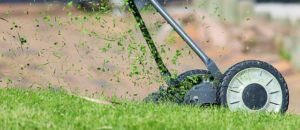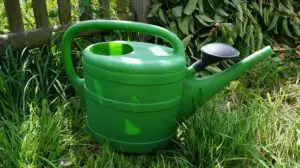This summer has been unusually hot in the UK and particularly in Essex where I am based and I have been looking at ways to cut down on watering my plants. So this post is all about how to conserve water during heatwaves.
On my allotment, once the water butts are empty, I have to use the water trough which is situated some distance from my plot. This is a problem every year but it’s even worse when it is so hot and everywhere is so dry. To water my plot adequately it takes 18 watering cans, each containing 2 gallons of water.
I am no longer a young man and so it’s becoming much more of a challenge to keep everything watered. I started using the wheelbarrow, as I found I can fit 3 watering cans in at a time. This cuts my trips to the trough down to 6 but of course it means each trip takes longer and the load is heavier.
How To Conserve Water During Heatwaves
So I started looking for ways to water less without causing the plants too much stress and also to conserve water especially during long, hot, dry spells. I read about semi desert plants and plants that need less water but it’s too late for that as my crops are already planted. Or I have already invested in the seeds to grow the same plants that I usually grow in my area.
So I have had to look at how to conserve water during heatwaves and I’m going to share my findings with you here.
Underground Water soakers
I started using this particular system many years ago to stop my runner beans from drying out. There’s much more detail on how to do it if you click the link. I dig a trench about 12 inches deep the length of my bed and line it with straw or newspaper (if using newspaper it needs to be 3-4 sheets in thickness). Give this a good soaking with water and then start to recover with soil.
Every 3 feet add a length of pipe or plastic bottle with the bottom cut off and leave enough of it protruding from the ground to be able to pour water into. So in a bed 12 foot in length you should have 4 pipes sticking up through the soil. You only need to water this twice a week even when temperatures are at their hottest as the water gets right to the root of the plants and doesn’t evaporate from the soil surface.
Mulch Around The Plants

Use grass cuttings as mulch
So straw/newspaper in place, plants in situ it’s time to mulch to conserve water and keep weeds at bay. Any water that you have struggled to get into the soil you want your plants to benefit from and not have to compete for it with weeds.
Definition of mulch
: a protective covering (as of sawdust, compost, or paper) spread or left on the ground to reduce evaporation, maintain even soil temperature, prevent erosion, control weeds, enrich the soil, or keep fruit (such as strawberries) clean
If you can get it, cover the ground with cardboard or damp newspaper (leaving holes around plants) Then cover with straw, compost, grass cuttings or any other non invasive plant material you can find. Instead of cardboard some people use polythene but this can cause excessive heat, slugs and snails seem to like it and it doesn’t rot down like all the other materials will to enhance your soil.
I am not a fan of using wood chippings/sawdust as a mulch. This is because during the process of breaking wood down into the soil, Nitrogen is used up and of course plants need nitrogen.
How To Conserve Water By Installing A Water Butt
On my plot I have 3 water butts, all recycled, 2 are 40 gallon drums with the lids cut off, and the third is a oblong tub measuring about 6 foot by 5 foot and standing about 4 foot high. These are fed from a runoff from my shed through a guttering system. They are all full at the beginning of the growing season and empty by about the middle of May, then the long walk to the troughs begin.
If you spot an old tub or container you think will make a good water butt always ask the owner if it’s ok to take it for recycling. Most people are only too pleased to see their junk being re-used but it makes sense to ask first and not get accused of stealing.
My guttering came from a skip and the owner even offered to help me fit it to my shed. I never had the necessary brackets but I found that screwing the gutter directly to the shed below the roof over hang works just fine.
When To Water
This is an important point that although seemingly obvious, needs to be made. Water your plants early in the morning or as late in the evening as possible. This will not only help conserve water through less transpiration and evaporation in your plants but will also keep you cooler.
How To Water

Water plants without rose to direct the water more accurately during heatwaves
When using a watering can it is best to take the rose off and just water through the nozzle. This is because you have more control on where the water actually goes, and you can water directly at the base of the plant (or into the pipe if you have the above system in place).
What Is Transpiration?
Transpiration is the process whereby plants absorb water through their roots and give off water vapour through pores in their leaves to cool the plant down. Much like us perspiring ( especially when struggling to water the allotment in a heatwave). The uplift of water through the plant pumps food and water to the leaves to allow photosynthesis to happen.
What Is Evaporation?
In plants evaporation is when the plants give off water vapour through pores in their leaves. This process is necessary for all plants although not for cacti as they don’t have leaves.
What Is Photosynthesis?
Photosynthesis is the process used by plants in which energy from sunlight is used to convert carbon dioxide and water into simple sugars that plants need to grow. The plants take in carbon dioxide and generate oxygen as a by product.
What Next?
According to the weather forecasters these long, hot, dry summers are going to occur with more frequency in the next few years. If that’s right then we all need to learn how to conserve water during heatwaves and preparation before we sow our seeds or plant our crops is going to be a necessity.
We should also be looking at more drought tolerant crops. The problem with all this is of course that forecasters get things wrong and news reporters over react. Sensation attracts readers/watchers, as I’ve always said the job of newspapers is to sell newspapers not report the truth. So don’t over react, grow what you like to grow.
Whether we do get hotter, dryer summers or not it is still a good idea to conserve water and ultimately our energy. So give these tips a try and let me know how you get on in the comments below.

